Nsg 557 - Study guides, Class notes & Summaries
Looking for the best study guides, study notes and summaries about Nsg 557? On this page you'll find 40 study documents about Nsg 557.
All 40 results
Sort by

-
NSG 557 Integumentary Test with Questions Solved 100% Correct
- Exam (elaborations) • 25 pages • 2024
- Available in package deal
-
- $13.24
- + learn more
Merkel Cell function somatosensory: light touch, neuroendocrine function? Which skin zone has the most genetic diseases? basement membrane zone Melanocytes synthesize the pigment melanin What happens during keratinization? flatten, lose organelles, form fibrous protein (keratin), dehydrate, thicken Predominant cells in the epidermis keratinocytes - 80%
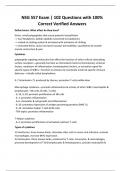
-
NSG 557 Exam | 102 Questions with 100% Correct Verified Answers
- Exam (elaborations) • 41 pages • 2024
- Available in package deal
-
- $13.49
- + learn more
Define kinins. What effect do they have? Kinins: small polypeptides that cause powerful vasodilation --> Ex// Bradykinin, kallidin (kallidin converted to bradykinin) --> Linked to clotting system & activated with activation of clotting --> Activated kinins cause increased vascular permeability, vasodilation & smooth muscle contraction & pain Cytokines polypeptide signaling molecules that affect the function of other cells by stimulating surface receptors—generally function as ...
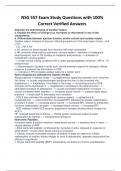
-
NSG 557 Exam Study Questions with 100% Correct Verified Answers
- Exam (elaborations) • 25 pages • 2024
- Available in package deal
-
- $13.49
- + learn more
escribe the determinants of Cardiac Output a. Explain the effect of change (e.g. increases or decreases) in any of the components. b. Differentiate between ejection fraction, stroke volume and cardiac output. Cardiac output: measure of amount of blood pumped out of the heart each minute, ~5-6 L/min · CO = HR X SV o SV: amount of blood ejected from ventricle with each contraction o HR: primarily influenced by autonomic nervous system—detection of inadequate blood pressure, lack of O2,...
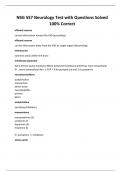
-
NSG 557 Neurology Test with Questions Solved 100% Correct
- Exam (elaborations) • 19 pages • 2024
- Available in package deal
-
- $12.99
- + learn more
afferent neuron carries information toward the CNS (ascending) efferent neuron carries information away from the CNS to target organ (descending) interneuron connects areas within the brain membrane potential NA-K ATPase pump maintains 90mV polarized membrane potential; more intracellular K+ ; more extracellular Na+; 1 ATP = 3 Na pumped out and 2 K pumped in
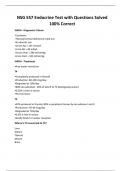
-
NSG 557 Endocrine Test with Questions Solved 100% Correct
- Exam (elaborations) • 16 pages • 2024
- Available in package deal
-
- $13.24
- + learn more
SIADH - Diagnostic Criteria -Euvolemic -Thyroid/cortisol deficiency ruled out -No diuretic use -Serum Na < 135 mmol/L -Urine Na > 40 mEq/L -Serum Osm < 280 mOsm/kg -Urine Osm > 100 mOsm/kg

-
NSG 557 Exam 2024 with Questions and 100% Correct Verified Answers
- Exam (elaborations) • 22 pages • 2024
- Available in package deal
-
- $13.24
- + learn more
Define cell injury. Occurs when cell is stressed to the point that the cell is NO LONGER able to adapt OR stress is inherently damaging OR stress causes an intrinsic abnormality (ex// important macromolecule becomes nonfunctional). Can be reversible, generally irreversible— injured cells do not function normally. à Note: cell function is lost before biochemical & morphological manifestations of injury are detected à Cell injury may be reversible (cell may recover & return to normal/ne...
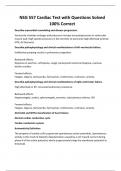
-
NSG 557 Cardiac Test with Questions Solved 100% Correct
- Exam (elaborations) • 14 pages • 2024
- Available in package deal
-
- $12.99
- + learn more
Describe myocardial remodeling and disease progression. Ventricular chamber enlarges and pressures increase increasing tension in ventricular muscle wall. High systolic pressures in the ventricle to overcome high afterload (arterial HTN, AV Stenosis). Describe pathophysiology and clinical manifestations of left-ventricular failure. Ineffective pumping results in pulmonary congestion. Backward effects: Dyspnea on exertion, orthopnea, cough, paroxysmal nocturnal dyspnea, cyanosis, basilar ...
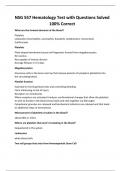
-
NSG 557 Hematology Test with Questions Solved 100% Correct
- Exam (elaborations) • 14 pages • 2024
- Available in package deal
-
- $12.99
- + learn more
What are the formed elements of the blood? Platelets Leukocytes (neutrophils, eosinophils, basophils, lymphocytes, monocytes) Erythrocytes Platelets Plate shaped membrane bound cell fragments formed from megakaryocytes No nucleus Not capable of mitotic division Average lifespan is 4-5 days
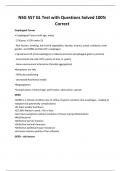
-
NSG 557 GL Test with Questions Solved 100% Correct
- Exam (elaborations) • 12 pages • 2024
- Available in package deal
-
- $12.99
- + learn more
Esophageal Cancer • Esophageal Cancer with age, males - 17k/year; <15% under 55 - Risk factors: smoking, low fruit & vegetables, obesity, trauma, urban, achalasia, male gender, and GERD and Barrett’s esophagus • Squamous Cell (mid-esophagus) or Adenocarcinoma (esophageal-gastric junction) - Inconsistent link with HPV (+parts of Asia, H. pylori) - Gene-environment interaction (familial aggregation) •Symptoms are late - Difficulty swallowing - decreased Nutritional intake •...
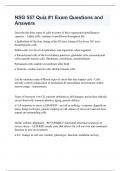
-
NSG 557 Quiz #1 Exam Questions and Answers
- Exam (elaborations) • 28 pages • 2024
-
- $13.99
- + learn more
Describe the three types of cells in terms of their regenerative/proliferative capacity. - Labile cells: continue to proliferate throughout life à Epithelium of the skin, lining of the GI tract, lining of the lower GU tract, hematopoietic cells Stable cells: low level of replication, can regenerate when signaled à Parenchymal cells of the liver/kidney/pancreas, glandular cells, mesenchymal cells (smooth muscle cells, fibroblasts, osteoblasts, chondroblasts) Permanent cells: unable to proli...

Study stress? For sellers on Stuvia, these are actually golden times. KA-CHING! Earn from your study resources too and start uploading now. Discover all about earning on Stuvia


